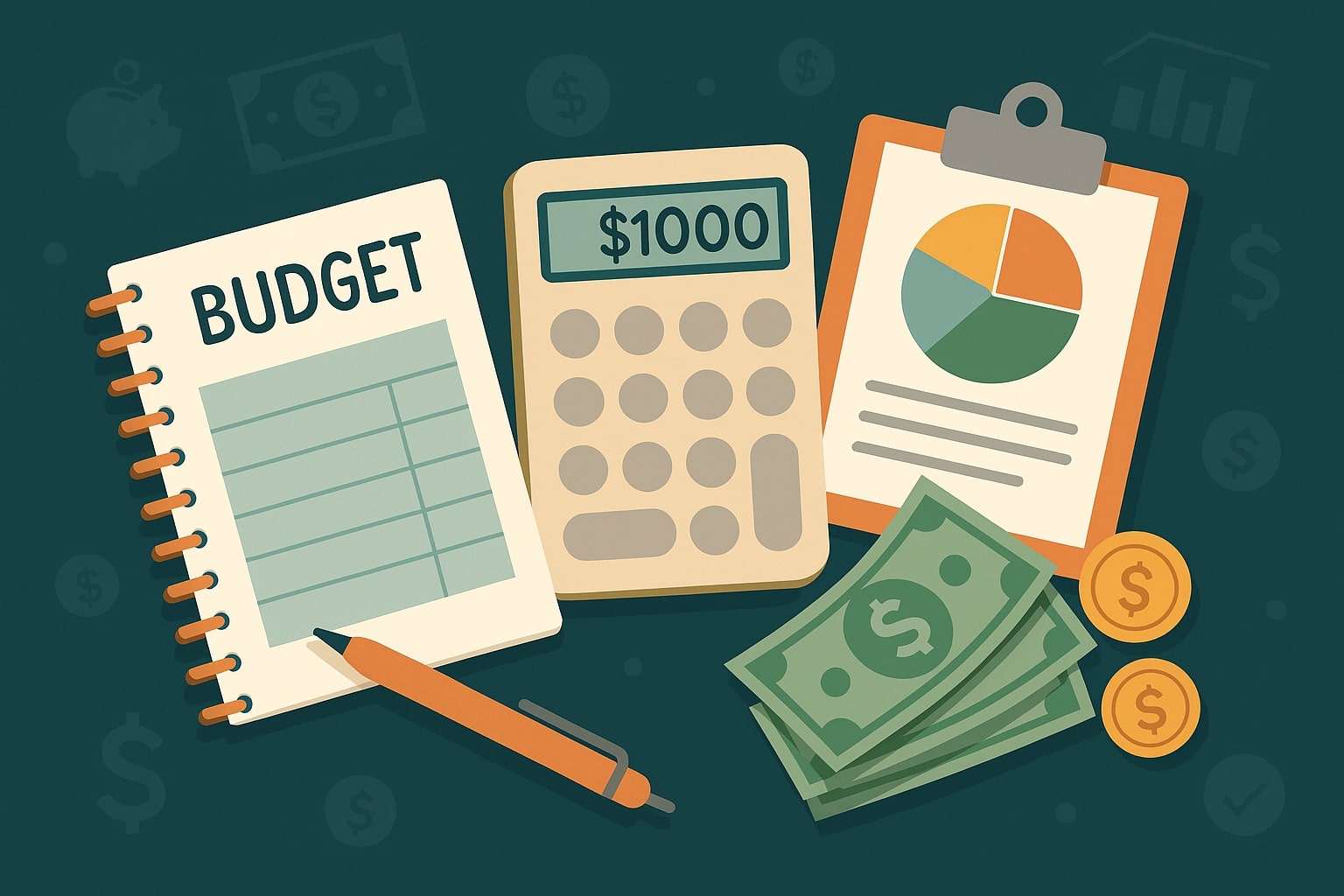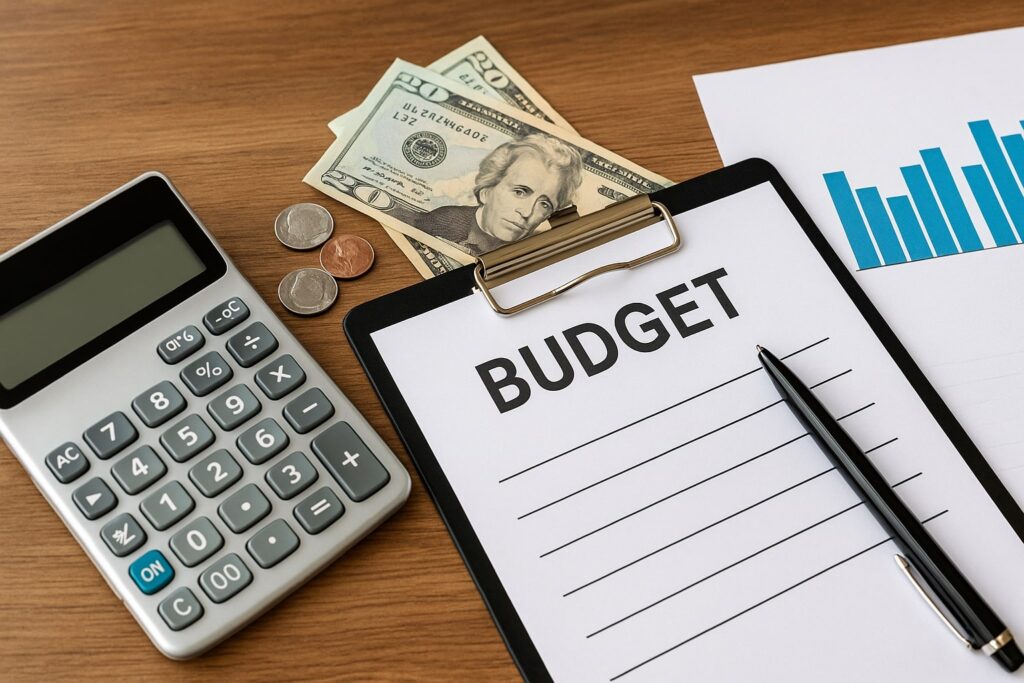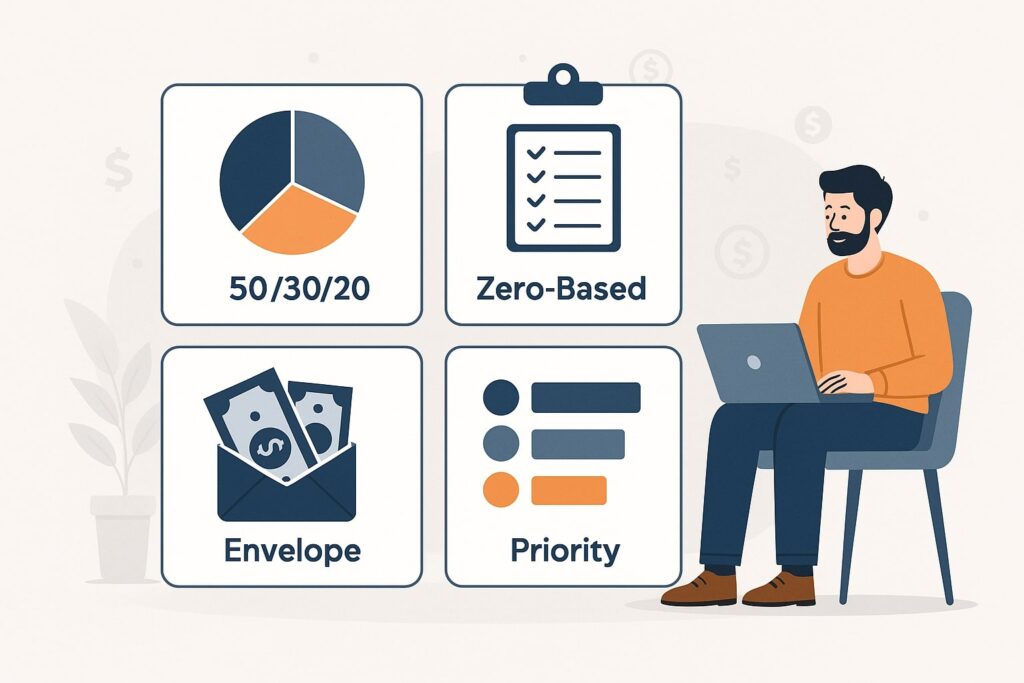
Budgeting Tips for New Entrepreneurs
Effective budgeting is essential for new entrepreneurs to manage cash flow, make informed decisions, and ensure long-term success. A business budget is essentially a spending plan based on projected income and expenses.
It forces startup owners to clarify their financial priorities, allocate resources wisely, and build a safety net for unexpected challenges. Yet many new business owners underestimate its importance – one survey found that 61% of startup owners don’t have an official budget, leaving them vulnerable to cash crunches and missed opportunities.
This guide provides budgeting tips for first-time entrepreneurs, focusing on practical steps, strategies, and tools that U.S. -based entrepreneurs can use to craft and maintain a solid financial plan.
Effective budgeting provides clear benefits: it helps allocate resources more efficiently, track actual spending against plans, and avoid cash flow problems.
By setting revenue targets and forecasting expenses (including fixed costs like rent or salaries, and variable costs like materials or marketing), you can determine how much profit remains for reinvestment.
Importantly, a well-planned budget builds resilience: setting aside funds for taxes and emergencies creates a “just-in-case” financial cushion. As a result, entrepreneurs who budget carefully are better prepared to adapt to rising costs or economic uncertainty (73% of U.S. small business owners surveyed were concerned about inflation).
Ultimately, budgeting is not about restricting your startup’s potential – it’s about making every dollar work toward your goals.
Understand Your Financial Landscape

Before creating a budget, get a clear picture of where your money is coming from and where it’s going. Gather financial documents (bank statements, receipts, invoices, loans, etc.) and review your personal and business finances.
Track all income and expenses for at least a month to see spending patterns. For example, many new entrepreneurs are surprised how small recurring costs (like daily coffee purchases) add up.
Write down your financial goals – e.g. sales targets, profit milestones, or funding needs – and use them to guide your budgeting. Clarity on your current situation and objectives will inform realistic estimates for sales forecasts and expense limits.
It’s also crucial to separate personal and business finances. Open a dedicated business bank account and credit card so that business transactions are not commingled with personal spending.
This simplifies accounting, tax filing, and financial tracking, and makes it easier to see exactly what your business earns and spends. With personal finances in order (including any debt obligations), you can focus on building your business budget without confusion or hidden costs.
Steps to Create Your Business Budget

Creating a practical budget involves several key steps, many of which overlap with the traditional accounting process:
- Estimate Projected Revenue. Start with your expected income for the budgeting period (often monthly or annually).
If your business is established, use historical sales data; if you’re a new startup, base revenue projections on market research, competitor analysis, and realistic sales goals.
It’s wise to prepare both a conservative (pessimistic) and an optimistic scenario to account for uncertainty. For example, consider your total addressable market and market share assumptions, then translate that into monthly sales figures.
Be conservative in these assumptions – experts recommend underestimating revenues and overestimating expenses to avoid unpleasant surprises. - List Fixed (Overhead) Costs. Identify all expenses that are relatively constant each month. Typical fixed costs include rent or mortgage, salaries and benefits, insurance premiums, loan payments, website hosting, utilities, and professional fees (accounting, legal).
Don’t overlook indirect fixed costs like taxes, licenses, or annual subscriptions. For each fixed cost category, budget for related spending as well (for example, budgeting not just the marketing salary but also software subscriptions and equipment it requires). - Identify Variable Costs. Variable costs change with your production or sales volume. Common variable expenses include raw materials, inventory, direct labor, packaging, utilities (if usage-based), commissions, advertising/marketing spend, shipping, and credit card fees.
Estimate these costs based on your revenue forecasts – for example, if you expect to sell 1,000 units, calculate material and production costs per unit. Gather quotes from suppliers or use industry averages.
It’s prudent to round up or add a buffer to variable cost estimates, especially for items that fluctuate (like doubling or tripling marketing and legal expense estimates if they tend to spike). - Include Startup and One-Time Costs. Many startups incur substantial one-time expenses before launch. These include capital expenditures (equipment, vehicles, furniture) and startup fees (permits, licenses, website development, brand design).
Keep these separate from recurring costs in your budget. Use resources like the SBA’s list of common startup costs (office space, inventory, advertising, legal fees, etc.) to ensure you capture all likely expenses.
Categorize one-time costs as capital investments or deductible expenses; the SBA notes that capital expenditures (like equipment) are not tax-deductible immediately, while startup expenses often are. - Set Aside Contingency and Emergency Funds. A critical component of any budget is a cushion for the unexpected. Financial experts recommend reserving funds equal to 3–6 months of expenses.
The U.S. Chamber of Commerce suggests budgeting a “just-in-case” fund (often around 10% of projected revenue) to cover unforeseen costs like equipment failure, economic downturns, or new opportunities.
Building this reserve means planning some deficit spending early on, but it provides peace of mind. As one CPA notes, this safety net is key because “there are always changes to your business, new investments to make”. - Calculate Profit and Loss. After listing all revenue and all categories of expenses (fixed, variable, one-time), add up the costs and subtract them from revenue to project your profit (or loss).
Create a simple Profit & Loss (P&L) statement or use a spreadsheet template to do this. Any positive remainder indicates profit available for reinvestment or owner pay; any deficit signals the need for adjustments.
If the initial budget shows a loss, prioritize cutting or delaying non-essential (discretionary) expenses before seeking more funding.
For example, question every line item: “Can we delay a marketing tool? Do we really need new furniture now?”. The process of labeling costs as necessary vs nice-to-have helps refine the budget. - Review and Adjust Regularly. A budget is a living document. At the end of each month (or quarter), compare actual results against your budget. Track variances: Where did you overspend? Where did revenue fall short or exceed expectations?
Use these insights to adjust future forecasts. Small business owners should schedule monthly budget reviews to catch issues early. As one finance expert advises, “Treat your budget as a living tool that needs regular attention”.
If needed, revise your spending plan – cut underperforming expense categories or reallocate funds toward more effective areas. This ongoing discipline ensures you stay on track and can adapt as the business grows.
Budgeting Methods and Strategies

Different businesses may use different budgeting approaches. The method you choose should fit your needs and size. Common budgeting styles include:
| Method | Description |
|---|---|
| Incremental | Start with last year’s budget and adjust by a set increment (e.g., inflation rate). This is easy but can perpetuate unnecessary spending. |
| Zero-Based | Build the budget from scratch each period, justifying every expense. This aligns spending tightly with goals and helps eliminate waste. |
| Activity-Based | Allocate funds based on the activities needed to reach targets (e.g. how many sales required for a revenue goal). This ensures resources directly support objectives. |
| Value-Proposition | Spend only on items that clearly drive customer or business value. Any expense that doesn’t add value is scrutinized or cut. |
Choosing a method depends on your preference and resources. Incremental and participative budgeting (involving managers) are simpler, but zero-based and value-driven approaches can be more precise in controlling costs. Whatever approach, keep your strategy consistent and involve key stakeholders if possible.
Smart Cost-Control Techniques

Beyond building the initial budget, entrepreneurs should continually look for ways to control costs and stretch every dollar:
- Negotiate with Vendors. Don’t accept the sticker price. Compare multiple suppliers, ask for discounts or better terms, and consider bulk or long-term contracts for lower rates.
For example, if office space is a large fixed cost, compare coworking options or negotiate rent concessions. - Be Strategic About Every Expense. Before spending, ask: “Does this expense move us toward a key business goal?”. Cut or delay any spending that isn’t essential.
For instance, one CPA advises, “Be frugal and avoid unnecessary expenses…only spend on items that directly contribute to growth”. Replace paid tools or subscriptions with free versions or lower-tier plans when possible, especially early on. - Reinvest Profits Wisely. When your business makes money, channel it back into the highest-impact areas.
Perhaps use profits to pay down debt faster, invest in a high-ROI marketing campaign, or build up inventory for anticipated demand. Don’t assume revenue growth means you can spend freely; reinvest cautiously. - Monitor Cash Flow Timing. Cash flow (when money actually flows in and out) is the lifeblood of a startup. Invoice promptly and follow up on receivables.
Schedule payments to suppliers so you take full advantage of payment terms (but don’t pay late and incur fees!). Align big expenses with incoming cash if possible. Keep at least 3–6 months of operating expenses in reserve. - Track Everything. Use budgeting software or even spreadsheets to categorize every expense. Digital tools can automate expense tracking (linking bank accounts or credit cards) so nothing slips through the cracks.
This makes reviewing budgets easier and ensures that the numbers you compare each month are accurate. - Plan for Taxes and Debt. In the U.S., set aside roughly a quarter to a third of expected profit for taxes (federal, state, self-employment, etc.) to avoid year-end shocks. Maintain good records for deductions (SBA notes that some startup costs are deductible).
Also, if you carry business debt, include interest and principal payments in your budget. A budget helps prevent surprise obligations and identifies when financing might be needed. - Use Free Resources and Advice. The U.S. Small Business Administration (SBA) and SCORE mentors offer free guidance on financial planning. The SBA business guide, for instance, covers balance sheets and cost-benefit analysis.
Local Small Business Development Centers (SBDCs) provide personalized coaching on cash flow and budgeting. Take advantage of these “people-first” resources – learning from experienced advisors can uncover overlooked tips and ensure you follow best practices.
Budgeting Tools and Resources

Modern entrepreneurs have many digital tools at their disposal to streamline budgeting:
- Accounting Software: Tools like QuickBooks, FreshBooks, or Xero automate expense tracking, invoicing, and reporting.
By linking your bank and credit card accounts, transactions populate automatically into categories. These platforms often include budgeting modules or P&L templates. - Spreadsheets and Templates: If you prefer a hands-on approach, spreadsheet programs (Excel, Google Sheets) are flexible.
Many free startup budget templates exist (for example, TemplateLab or QuickBooks templates). Using a template saves time, as formulas for totals and variances are built in. - Specialized Budgeting Apps: Programs like You Need a Budget (YNAB) or Mint (for small business or personal use) can help allocate every dollar and visualize cash flows.
There are also robust planning tools like LivePlan, Jirav, or Scoro for growing businesses, though they often require subscriptions. Many banks (like Bank of America) provide budget calculators or tutorials online as well. - SBA and Government Calculators: For startups, use the SBA’s online worksheets and break-even calculators. They help estimate when your business will become profitable and how much funding you need.
- Financial Advisers and CPAs: Especially when numbers get complex, consulting a CPA or fractional CFO can pay dividends. These pros can set up your budgeting framework, choose the right accounting method (cash vs. accrual), and ensure compliance with tax laws.
Building expertise (or tapping into expert networks) improves E-E-A-T (Experience, Expertise, Authority, Trust) of your planning.
Regardless of tools, the key is consistent use. Integrate your budgeting app or spreadsheet into your routine so you always know the real-time status of your finances.
Frequently Asked Questions
Q.1: Why is budgeting important for new entrepreneurs?
Answer: Budgeting provides a clear financial roadmap. It shows how much revenue you need, where money will be spent, and how much profit (or cushion) remains. It helps avoid unexpected cash shortages, plan for taxes and emergencies, and make informed decisions. As one expert puts it, a budget gives you clarity on spending and acts as a roadmap for growth.
Q.2: How do I start creating a budget for my startup?
Answer: Begin by listing all your expected income sources and expenses. Estimate sales using market research, then list fixed costs (rent, salaries, insurance, etc.) and variable costs (materials, utilities, marketing). Include one-time startup costs (equipment, licenses) and reserve a contingency fund for surprises. Subtract expenses from revenue to see profit or loss, then refine as needed.
Q.3: What expenses should I include in my startup budget?
Answer: Include all relevant costs. Common categories are office rent, salaries/benefits, utilities, insurance, supplies, marketing, licenses, loan repayments, and professional services.
Don’t forget the owner’s salary (if applicable) and taxes (set money aside for income and payroll taxes). Also plan for inventory and raw materials, plus small ongoing costs like website hosting or software subscriptions.
Q.4: How often should I update my budget?
Answer: Your budget should be updated regularly—at least monthly or quarterly. Many entrepreneurs perform monthly reviews, comparing actual income/expenses to the budget and adjusting future months’ plans accordingly.
This ongoing process ensures you catch variances early and adapt. If seasonal fluctuations are big in your industry, more frequent (weekly) checks on cash flow may be needed.
Q.5: What budgeting tools are good for entrepreneurs?
Answer: Popular tools include accounting software like QuickBooks, FreshBooks, or Xero, which integrate banking data and produce financial reports. Spreadsheets (Excel/Google Sheets) with templates are also widely used, especially at first.
Other apps like Mint, You Need A Budget (YNAB), or startup planning tools (LivePlan, Budgeto) can help automate tracking and forecasting. Choose a tool you will consistently use; the best budget is one you update and consult regularly.
Q.6: How much should I save for taxes as a new business?
Answer: A general rule is to set aside 25–30% of your net income (profits) for federal, state, and self-employment taxes. Exact rates depend on your location and business structure. Many entrepreneurs “pay themselves” by transferring pre-tax funds to a separate tax account each month. Consult a CPA for precise estimates and make quarterly tax payments to avoid penalties.
Q.7: How big of an emergency fund should my startup have?
Answer: Aim to save 3–6 months of operating expenses if possible. This fund covers unexpected slow sales or urgent costs. If that target is out of reach initially, budget as much as you can. Even saving a small cushion helps; for example, set aside a percentage of each sale into a “rainy day” account.
Each of these tips and practices is backed by financial experts and successful entrepreneurs. By following a disciplined, realistic budgeting approach tailored to your business, you’ll have the financial guidance needed to make smart decisions and grow sustainably.
Conclusion
Budgeting is one of the most important financial disciplines for first-time entrepreneurs. By following these budgeting tips for new entrepreneurs, you create a roadmap for your business and reduce uncertainty.
Build your budget on realistic revenue forecasts and detailed cost estimates, be conservative with assumptions, and always include a cushion for surprises. Separate personal and business finances, and revisit your budget regularly – monthly reviews ensure it stays aligned with your evolving goals.
With a well-constructed budget, you can make strategic decisions, demonstrate financial discipline to investors or lenders, and steer your startup toward growth. Remember, budgeting isn’t about micromanaging every penny; it’s about empowering yourself to spend purposefully and plan for a secure financial future.